Zhenggang Tang
MV-DUSt3R+: Single-Stage Scene Reconstruction from Sparse Views In 2 Seconds
Dec 09, 2024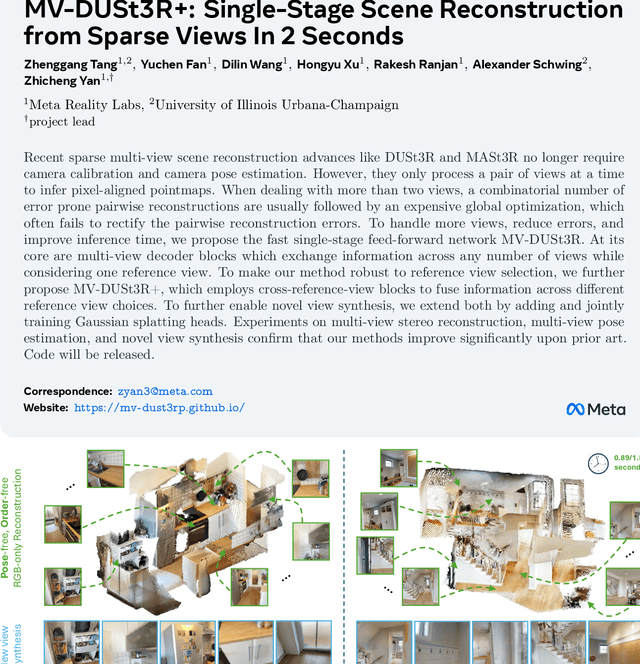


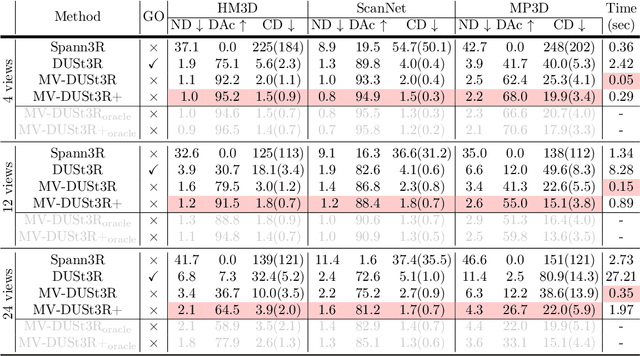
Abstract:Recent sparse multi-view scene reconstruction advances like DUSt3R and MASt3R no longer require camera calibration and camera pose estimation. However, they only process a pair of views at a time to infer pixel-aligned pointmaps. When dealing with more than two views, a combinatorial number of error prone pairwise reconstructions are usually followed by an expensive global optimization, which often fails to rectify the pairwise reconstruction errors. To handle more views, reduce errors, and improve inference time, we propose the fast single-stage feed-forward network MV-DUSt3R. At its core are multi-view decoder blocks which exchange information across any number of views while considering one reference view. To make our method robust to reference view selection, we further propose MV-DUSt3R+, which employs cross-reference-view blocks to fuse information across different reference view choices. To further enable novel view synthesis, we extend both by adding and jointly training Gaussian splatting heads. Experiments on multi-view stereo reconstruction, multi-view pose estimation, and novel view synthesis confirm that our methods improve significantly upon prior art. Code will be released.
Pixel-Aligned Multi-View Generation with Depth Guided Decoder
Aug 26, 2024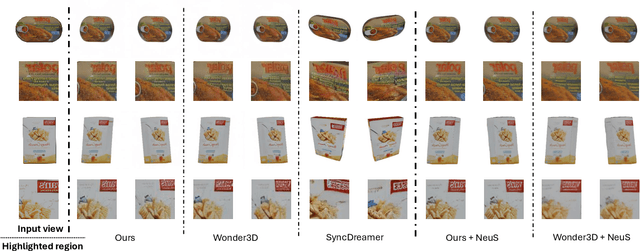
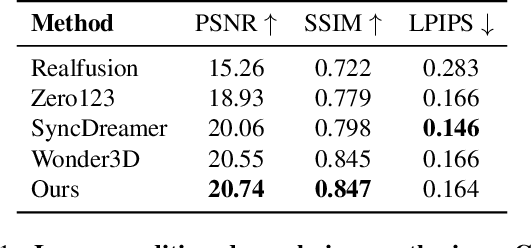
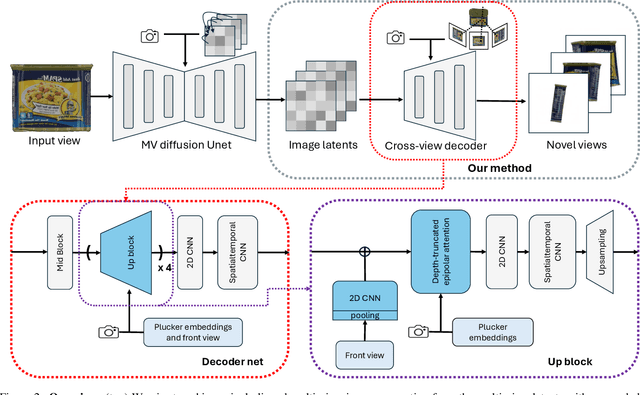

Abstract:The task of image-to-multi-view generation refers to generating novel views of an instance from a single image. Recent methods achieve this by extending text-to-image latent diffusion models to multi-view version, which contains an VAE image encoder and a U-Net diffusion model. Specifically, these generation methods usually fix VAE and finetune the U-Net only. However, the significant downscaling of the latent vectors computed from the input images and independent decoding leads to notable pixel-level misalignment across multiple views. To address this, we propose a novel method for pixel-level image-to-multi-view generation. Unlike prior work, we incorporate attention layers across multi-view images in the VAE decoder of a latent video diffusion model. Specifically, we introduce a depth-truncated epipolar attention, enabling the model to focus on spatially adjacent regions while remaining memory efficient. Applying depth-truncated attn is challenging during inference as the ground-truth depth is usually difficult to obtain and pre-trained depth estimation models is hard to provide accurate depth. Thus, to enhance the generalization to inaccurate depth when ground truth depth is missing, we perturb depth inputs during training. During inference, we employ a rapid multi-view to 3D reconstruction approach, NeuS, to obtain coarse depth for the depth-truncated epipolar attention. Our model enables better pixel alignment across multi-view images. Moreover, we demonstrate the efficacy of our approach in improving downstream multi-view to 3D reconstruction tasks.
NeRFDeformer: NeRF Transformation from a Single View via 3D Scene Flows
Jun 15, 2024Abstract:We present a method for automatically modifying a NeRF representation based on a single observation of a non-rigid transformed version of the original scene. Our method defines the transformation as a 3D flow, specifically as a weighted linear blending of rigid transformations of 3D anchor points that are defined on the surface of the scene. In order to identify anchor points, we introduce a novel correspondence algorithm that first matches RGB-based pairs, then leverages multi-view information and 3D reprojection to robustly filter false positives in two steps. We also introduce a new dataset for exploring the problem of modifying a NeRF scene through a single observation. Our dataset ( https://github.com/nerfdeformer/nerfdeformer ) contains 113 synthetic scenes leveraging 47 3D assets. We show that our proposed method outperforms NeRF editing methods as well as diffusion-based methods, and we also explore different methods for filtering correspondences.
Learning Multi-Agent Intention-Aware Communication for Optimal Multi-Order Execution in Finance
Jul 06, 2023Abstract:Order execution is a fundamental task in quantitative finance, aiming at finishing acquisition or liquidation for a number of trading orders of the specific assets. Recent advance in model-free reinforcement learning (RL) provides a data-driven solution to the order execution problem. However, the existing works always optimize execution for an individual order, overlooking the practice that multiple orders are specified to execute simultaneously, resulting in suboptimality and bias. In this paper, we first present a multi-agent RL (MARL) method for multi-order execution considering practical constraints. Specifically, we treat every agent as an individual operator to trade one specific order, while keeping communicating with each other and collaborating for maximizing the overall profits. Nevertheless, the existing MARL algorithms often incorporate communication among agents by exchanging only the information of their partial observations, which is inefficient in complicated financial market. To improve collaboration, we then propose a learnable multi-round communication protocol, for the agents communicating the intended actions with each other and refining accordingly. It is optimized through a novel action value attribution method which is provably consistent with the original learning objective yet more efficient. The experiments on the data from two real-world markets have illustrated superior performance with significantly better collaboration effectiveness achieved by our method.
A Microscopic Pandemic Simulator for Pandemic Prediction Using Scalable Million-Agent Reinforcement Learning
Aug 14, 2021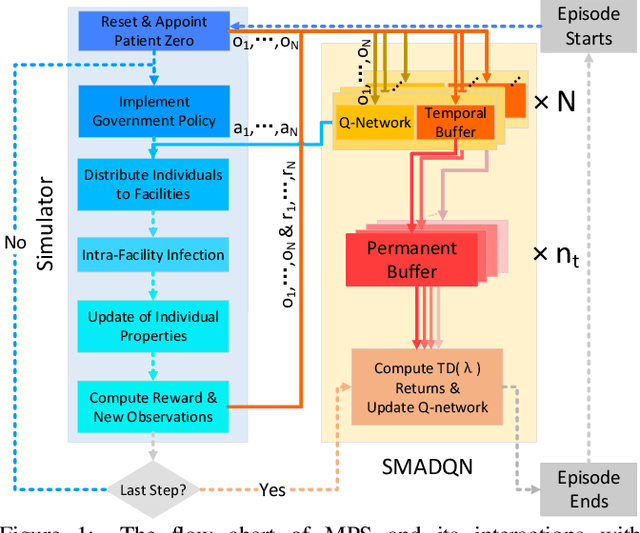



Abstract:Microscopic epidemic models are powerful tools for government policy makers to predict and simulate epidemic outbreaks, which can capture the impact of individual behaviors on the macroscopic phenomenon. However, existing models only consider simple rule-based individual behaviors, limiting their applicability. This paper proposes a deep-reinforcement-learning-powered microscopic model named Microscopic Pandemic Simulator (MPS). By replacing rule-based agents with rational agents whose behaviors are driven to maximize rewards, the MPS provides a better approximation of real world dynamics. To efficiently simulate with massive amounts of agents in MPS, we propose Scalable Million-Agent DQN (SMADQN). The MPS allows us to efficiently evaluate the impact of different government strategies. This paper first calibrates the MPS against real-world data in Allegheny, US, then demonstratively evaluates two government strategies: information disclosure and quarantine. The results validate the effectiveness of the proposed method. As a broad impact, this paper provides novel insights for the application of DRL in large scale agent-based networks such as economic and social networks.
Discovering Diverse Multi-Agent Strategic Behavior via Reward Randomization
Mar 12, 2021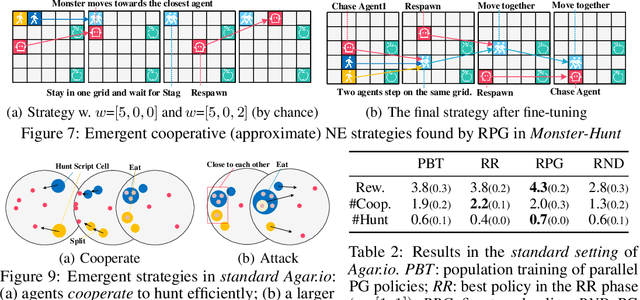
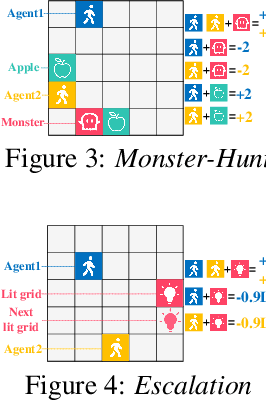

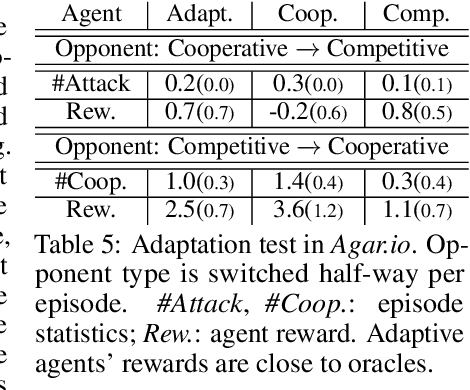
Abstract:We propose a simple, general and effective technique, Reward Randomization for discovering diverse strategic policies in complex multi-agent games. Combining reward randomization and policy gradient, we derive a new algorithm, Reward-Randomized Policy Gradient (RPG). RPG is able to discover multiple distinctive human-interpretable strategies in challenging temporal trust dilemmas, including grid-world games and a real-world game Agar.io, where multiple equilibria exist but standard multi-agent policy gradient algorithms always converge to a fixed one with a sub-optimal payoff for every player even using state-of-the-art exploration techniques. Furthermore, with the set of diverse strategies from RPG, we can (1) achieve higher payoffs by fine-tuning the best policy from the set; and (2) obtain an adaptive agent by using this set of strategies as its training opponents. The source code and example videos can be found in our website: https://sites.google.com/view/staghuntrpg.
 Add to Chrome
Add to Chrome Add to Firefox
Add to Firefox Add to Edge
Add to Edge